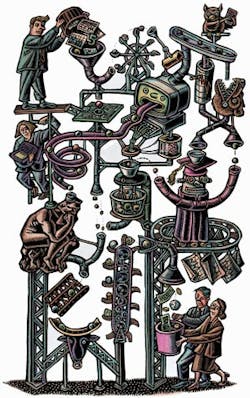Let’s face reality—the people in marketing cannot accurately predict the future. As a result, there is always a difference between what was built and what customers actually buy. Those with assembly lines have additional constraints that compound the problem. Changing the line over for the needed products is expensive and often contrary to the production manager’s metrics.Another key issue is changes in the volume and mix (options) of incoming orders, which require the line to be rebalanced. The corresponding line changes permeate and echo through the production systems as work sequence rules and productivity issues are adjusted.These imbalances (forecast vs. orders, volume and mix) have been exacerbated by some recent trends. One is product proliferation. More product variation leads to more items to forecast, with a greater likelihood of being wrong, and more mix variation. In the past, companies attempted to constrain product variation. Today, being competitive and growing the business demands product variety. A second trend is reducing set-up so the line is easier to change over. This helps manufacturers move to assemble-to-order (ATO) and eliminate finished goods inventory. A third trend is just-in-time (JIT) inventory management. In the past, inventory of raw materials would buffer the errors in the forecast and provide the materials needed to make the products that were actually purchased. Today, it is impractical for companies to have enough inventory to provide for every potential product variation.These recent trends, along with the adoption of ATO and JIT, are driving the development of advanced software applications that can manage the complexity and provide the needed fast response to exceptions.For example, today, most cars are assembled for a particular dealer order. On the surface, this may sound simple, but execution quickly gets complicated. Hundreds of subassemblies and components must get to the production line at the right time and in the right sequence. Meanwhile, the sequence may change due to an exception that occurs while the cars are moving down the assembly line. Controlling the flow of materials is non-trivial, to say the least. Sophisticated software systems are needed to manage the sequence, routing, quality and exceptions. They provide support in three major areas: assembly line sequencing, assembly line broadcast and control, and supplier sequencing.In the past, auto original equipment manufacturers with high product variety wrote their own custom systems to control and manage their production lines. Many companies have multiple plants with each one having its own custom applications tailored to the site’s idiosyncrasies. Each site has its own support staff, which consists of a few people intimately knowledgeable with the software and able to support it.Rapid changes in technology, thinner operating margins and rising availability of packaged applications are drivers for buying, rather than making. Commercial software packages are designed to be flexible to meet the needs of multiple customers. With multiple installations and an infrastructure of support, they are more robust. A few packaged software application suppliers have emerged.Continuous assembly lines are expensive to run and produce significant revenue. An outage will have an impact that ranges from $100,000 to $1 million per hour. Applications age as technology changes and industry business practices improve. If you are converting to ATO and have a prolific product line with many options, packaged software should be considered. If your assembly line sequencing, broadcast and control applications are more than seven years old, they should be examined for replacement.Ralph Rio, [email protected], is Research Director, Enterprise Software, at ARC Advisory Group Inc., in Dedham, Mass.
About the Author
Sign up for our eNewsletters
Get the latest news and updates

Leaders relevant to this article:
